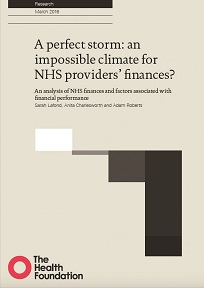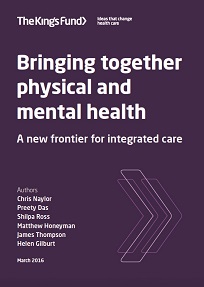News / News analysis: Crunch time

The crunch financial year for the NHS has ended, but perhaps only now the fallout will begin as the true financial picture for 2015/16 emerges in the next few months.
With forecasts at the beginning of the final quarter pointing to a provider overspend of up to £2.8bn, the service had a mountain to climb to meet the £1.8bn deficit control total set by the Treasury for the NHS as a whole. So much rests on achieving this figure, including the service's ability to meet its 2016/17 control totals, and national bodies seem determined to pull out all the stops to make it happen.
For several months, Monitor and the NHS Trust Development Authority (the chief constituents of the newly launched NHS Improvement) have urged trusts to explore every legitimate avenue to reduce their deficits. These include technical measures such as accruals, bad debt provisions and capital-to-revenue transfers. But while no one would expect the general public to understand these technical measures, the mere mention is enough to arouse suspicion that the NHS is ‘hiding’ its true deficit.
This suspicion increased when it emerged that the Department of Health had decided to send ‘small teams of accountants’ to a number of trusts to examine their application of accounting policies and to scrutinise transactions to ensure guidance has not been misinterpreted.
The paradox of hiring external consultants when cost-cutting is limiting trust consultancy spending was not lost on finance managers.
In a letter to the trusts selected for the visits, the Department said that the purpose was to support its group accounts and not to critique the trust financial statements. These would continue to be audited by their external auditor.
However, suspicion remained – one commentator described the moves as fiddling the figures by, for example, booking income in 2015/16 and pushing expenditure into 2016/17. The HFMA said the additional due diligence was highly unusual and could cause significant difficulties if differences in opinion arise.
The financial difficulties enveloping the NHS – and the need for action – are not in dispute. But turnaround will be complex, a fact highlighted in a Commons Public Accounts Committee (PAC) report last month. The committee expressed its deepening concern about the financial future of the NHS and said it was not convinced the government had a convincing plan to close the expected £22bn efficiency gap over the spending review period.
Unrealistic targets
The requirement for trusts to make 4% efficiency savings across the board in 2015/16 was unrealistic and had done long-term damage to trust finances, the committee said. And it added that the reference cost data used by the Carter efficiency review to estimate trusts’ potential savings was ‘seriously flawed’. NHS Improvement must set out how it will work with trusts to improve the quality of cost data in 2016/17, it said.
All trusts in deficit should have realistic recovery plans in place by the beginning of the 2016/17 financial year, the committee said. And, as a matter of urgency, NHS England and NHS Improvement should set out how they will support providers to secure the collective action needed to get value for money from the use of agency staff.
PAC chair Meg Hillier said: ‘Acute hospital trusts are at crisis point. Central government has done too little to support trusts facing financial problems, with the result that overall deficits are growing at a truly alarming rate. Crude efficiency targets have made matters worse. Without urgent action to put struggling trusts on a firmer financial footing there is further serious risk to services and the public purse.’
She added that it was unacceptable for senior government officials simply to point to excessive agency costs as a source of trusts’ difficulties; they must address the underlying causes.
‘There is a long way to go before the taxpayer will be convinced that there is a workable and properly costed plan in place to secure the future of our health service,’ she said.
The committee expects the Department, NHS England and NHS Improvement to report on progress in September.
System focus
NHS Providers chief executive Chris Hopson said the committee had echoed reports from the front line. ‘This report confirms what our members have been saying for the past 18 months: the financial crisis in NHS hospitals and other providers is due to the fundamental mismatch between what NHS providers have been asked to deliver and the resources they have been given,’ he said. ‘It is not a function of the performance of individual foundation trusts and trusts. Therefore, we need corresponding system-wide action to help get all frontline NHS providers out of this crisis.’
Earlier in the month, the Health Foundation had also highlighted the role of system pressures in provider deficits. Its report, A perfect storm: an impossible climate for NHS providers’ finances?, said pressures beyond trusts’ control were contributing to their financial troubles. It said a rising pay bill and the national tariff were among the driving forces behind the overall deficit position in acute hospitals in England. Poor-quality care was often associated with deficits. Acute and specialist trusts found to be inadequate by the Care Quality Commission were more likely to be in deficit than other trusts.
Foundation research and economics director Anita Charlesworth said the NHS faced another five years of austerity. Productivity improvements were needed to ensure patient care did not suffer. ‘The financial challenges facing our hospitals are not the result of weaknesses in the management of individual organisations,’ she said.
‘They stem from poor workforce planning and fundamentally an unrealistic expectation of efficiency improvement in the NHS. Providers are now between a rock and a hard place. Training places for nurses have fallen 20% over the last decade, while demand rose due to rising activity levels. Demand for nursing staff further increased in the wake of the Mid Staffs Inquiry. Far from mushrooming, nurse to patient bed
day ratios have now only returned to 2011 levels and the need for staffing increases could have been foreseen.’
Deficit warning
While the MPs on the PAC were putting together their report, their colleagues on the Commons Health Committee were hearing that it is unlikely trusts in England will eliminate their aggregate deficit by the end of 2016/17.
In evidence to the committee’s inquiry on the spending review settlement for health and social care, NHS Providers said its current best estimate was that providers would reach the end of 2016/17 with an overall £500m deficit.
The evidence added that clarity was needed over funding for government policy commitments and it warned large-scale transformational change could take decades.
Mr Hopson acknowledged the NHS had received a relatively good settlement in the spending review, but added that it was in the middle of the longest and deepest financial squeeze in its history.
‘The “front-loaded” investment over the next two years will help to ease the pressure, but there must be concern over the back end of this parliament, when the funding increases will be much lower,’ he said.
The annus horribilis is over, although the final position remains on a knife edge, and 2016/17 looks brighter. Guidance and policy aim to rebalance trust finances – through the sustainability and transformation fund and a higher overall tariff uplift. However, finance directors will be nervous about their ability to recover their financial position while maintaining staff morale and the quality of patient services.
Integrated opportunity
While NHS acute providers struggle to contain their aggregate overspend in 2015/16, the King’s Fund believes they could avoid some costs through better integration of physical and mental health services.
Lack of integration between physical and mental healthcare is costing the NHS £11bn a year, it said, and integration could improve outcomes for patients and save money.
The £11bn cost is the result of several factors: high rates of mental health issues among patients with long-term conditions such as cancer and heart disease; limited support for the psychological aspects of physical health issues – for example, during and after pregnancy; and poor management of medically unexplained symptoms such as tiredness or pain with no obvious cause.
It added people with mental illness live 15 to 20 years less than the general population, largely as a result of physical ill health.
The King’s Fund report, Bringing together physical and mental health: a new frontier for integrated care, identified 10 areas where mental health input could be enhanced in acute and primary care settings while also improving physical health assessments in mental health inpatient facilities.
Chris Naylor, senior fellow at the fund, said: ‘Traditionally physical and mental health have operated as distinct, separate systems in terms of treatment and funding. That is no longer affordable financially or acceptable clinically. The government has set the goal of parity of esteem, meaning mental healthcare should be “as good as” physical healthcare. We argue that there is an even greater prize at stake – that mental health care should be delivered “as part of” an integrated approach to health.
‘When we spoke to patients they told us they wanted to see healthcare professionals who recognised all of their care needs. What’s more, at £11bn a year, the disconnect between treating physical and mental health is costing the NHS greatly and isn’t meeting patient needs.’
Related content
The Institute’s annual costing conference provides the NHS with the latest developments and guidance in NHS costing.
The value masterclass shares examples of organisations and systems that have pursued a value-driven approach and the results they have achieved.